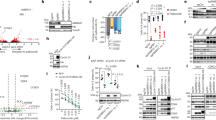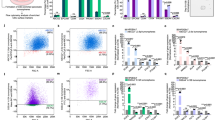Abstract
The BMI1 polycomb protein regulates self-renewal, proliferation and survival of cancer-initiating cells essentially through epigenetic repression of the CDKN2A tumor suppressor locus. We demonstrate here for the first time that BMI1 also prevents autophagy in chronic myeloid leukemia (CML) cell lines, to support their proliferation and clonogenic activity. Using chromatin immunoprecipitation, we identified CCNG2/cyclin G2 (CCNG2) as a direct BMI1 target. BMI1 downregulation in CD34+ CML cells by PTC-209 pharmacological treatment or shBMI1 transduction triggered CCNG2 expression and decreased clonogenic activity. Also, ectopic expression of CCNG2 in CD34+ CML cells strongly decreased their clonogenicity. CCNG2 was shown to act by disrupting the phosphatase 2A complex, which activates a PKCζ-AMPK-JNK-ERK pathway that engages autophagy. We observed that BMI1 and CCNG2 levels evolved inversely during the progression of CML towards an acute deadly phase, and therefore hypothesized that BMI1 could support acute transformation of CML through the silencing of a CCNG2-mediated tumor-suppressive autophagy response.
This is a preview of subscription content, access via your institution
Access options
Subscribe to this journal
Receive 12 print issues and online access
$259.00 per year
only $21.58 per issue
Buy this article
- Purchase on Springer Link
- Instant access to full article PDF
Prices may be subject to local taxes which are calculated during checkout







Similar content being viewed by others
References
Sparmann A, van Lohuizen M . Polycomb silencers control cell fate, development and cancer. Nat Rev Cancer 2006; 6: 846–856.
Hosen N, Yamane T, Muijtjens M, Pham K, Clarke MF, Weissman IL . Bmi-1-green fluorescent protein-knock-in mice reveal the dynamic regulation of bmi-1 expression in normal and leukemic hematopoietic cells. Stem Cells 2007; 25: 1635–1644.
Iwama A, Oguro H, Negjshi M, Kato Y, Morita Y, Tsukui H, et al. Enhanced self-renewal of hematopoietic stem cells mediated by the polycomb gene product Bmi-1. Immunity 2004; 21: 843–851.
Lessard J, Sauvageau G . Bmi-1 determines the proliferative capacity of normal and leukaemic stem cells. Nature 2003; 423: 255–260.
Park I, Qian D, Kiel M, Becker M, Pihalja M, Weissman I, et al. Bmi-1 is required for maintainance of adult sef-renewing haematopoietic stem cells. Nature 2003; 423: 302–305.
van Lohuizen M, Verbeek S, Scheijen B, Wientjens E, van der Gulden H, Berns A . identification of cooperating oncogenes in E mu-myc transgenic mice by provirus tagging. Cell 1991; 31: 737–752.
Raaphorst F, Otte A, Meijer J . Polycomb-group genes as regulators of mammalian lymphopoiesis. Trends Immunol 2001; 22: 682–690.
Kreso A, van Galen P, Pedley NM, Lima-Fernandes E, Frelin C, Davis T, et al. Self-renewal as a therapeutic target in human colorectal cancer. Nat Med 2014; 20: 29–36.
Valk-Lingbeek ME, Bruggeman SW, van Lohuizen M . Stem cells and cancer; the polycomb connection. Cell 2004; 118: 409–418.
Oguro H, Iwama A, Morita Y, Kamijo T, van Lohuisen M, Nakauchi H . Differential impact of Ink4a and Arf on hematopoietic stem cells and their bone marrow microenvironment in bmi-1-deficient mice. J Exp Med 2006; 203: 2247–2253.
Jacobs J, Kieboom K, Marino S, DePinho RA, van Lohuizen M . The oncogene and Polycomb-group gene Bmi-1 regulates cell proliferation and senescence through the ink4a locus. Nature 1999; 397: 164–168.
Smith K, Chanda S, Lingbeek M, Ross D, Botstein D, van Lohuizen M, et al. Bmi-1 regulation of INK4A-ARF is a downstream requirement for transformation of hematopoietic progenitors by E2a-Pbx1. Mol Cell 2003; 12: 393–400.
Kim W, Sharpless N . The regulation of INK4/ARF in cancer and aging. Cell 2006; 127: 265–275.
Kusy S, Larsen CJ, Roche J . p14ARF, p15INK4b and p16INK4a methylation status in chronic myelogenous leukemia. Leuk Lymphoma 2004; 45: 1989–1994.
Nagy E, Beck Z, Kiss A, Csoma E, Telek B, Konya J, et al. Frequent methylation of p16INK4A and p14ARF genes implicated in the evolution of chronic myeloid leukaemia from its chronic to accelerated phase. Eur J Cancer 2003; 39: 2298–2305.
Bhattacharyya J, Mihara K, Yasunaga S, Tanaka H, Hoschi M, Kimura A . Bmi-1 expresion is enhanced through transcriptional and posttranscriptional regulation during the progression of chronic myeloid leukemia. Ann Hematol 2009; 88: 333–340.
Rui H, Su J . Co-transfection of p16INK4a and p53 genes into the K562 cell line inhibits cell proliferation. Haematologica 2002; 87: 136–142.
Colosetti P, Puissant A, Robert G, Luciano F, Jacquel A, Gounon P, et al. Autophagy is an important event for megakaryocytic differentiation of the chronic myelogenous leukemia K562 cell line. Autophagy 2009; 5: 1092–1098.
Arachchige Don A, Dallapiazza R, Bennin D, Brake T, Cowan C, Horne M . Cyclin G2 is a centrosome-associated nucleo-cytoplasmic shuttling protein that influences microtubule stability and induces a p53-dependent cell cycle arrest. Exp Cell Res 2006; 312: 4181–4204.
Wu SC, Solaro RJ . Protein kinase C zeta. A novel regulator of both phosphorylation and de-phosphorylation of cardiac sarcomeric proteins. J Biol Chem 2007; 282: 30691–30698.
Xiao H, Bai XH, Wang Y, Kim H, Mak AS, Liu M . MEK/ERK pathway mediates PKC activation-induced recruitment of PKCzeta and MMP-9 to podosomes. J Cell Physiol 2013; 228: 416–427.
Radich JP, Dai H, Mao M, Oehler V, Schelter J, Druker B, et al. Gene expression changes associated with progression and response in chronic myeloid leukemia. Proc Natl Acad Sci USA 2006; 103: 2794–2799.
Liu J, Cao L, Chen J, Song S, Lee I, Quijano C, et al. Bmi-1 regulates mitochondrial function and the DNA damage response pathway. Nature 2009; 459: 387–392.
Jagani Z, Wiederschain D, Loo A, He D, Mosher R, Fordjour P, et al. The Polycomb group protein Bmi-1 is essential for the growth of multiple myeloma cells. Cancer Res 2010; 70: 5528–5538.
Yamashita M, Kuwahara M, Suzuki A, Hirahara K, Shinnaksu R, Hosokawa H, et al. Bmi1 regulates memory CD4 T cell survival via repression of the Noxa gene. J Exp Med 2008; 205: 1109–1120.
Bruggeman SW, Hulsman D, Tanger E, Buckle T, Blom M, Zevenhoven J, et al. Bmi1 controls tumor development in an Ink4a/Arf-independent manner in a mouse model for glioma. Cancer Cell 2007; 12: 328–341.
Hoenerhoff M, Chu I, Barkan D, Liu Z-y, Datta S, Dimri G, et al. BMI1 cooperates with H-RAS to induce an aggressive breast cancer phenotype with brain metastases. Oncogene 2009; 28: 3022–3032.
Bates S, Rowan S, Vousden K . Characterization of human cyclin G1 and G2: DNA damage inducible genes. Oncogene 1996; 13: 1103–1109.
Martinez-Gac L, Marques M, Garcia Z, Campanero M, Carrera A . Control of cyclin G2 mRNA expression by forkhead transcription factors: novel mechanism for cell cycle control by phosphoinositide 3-kinase and forkhead. Mol Cell Biol 2004; 24: 2181–2189.
Xu G, Bernaudo S, GFu G, Lee D, Yang B, Peng C . Cyclin G2 is degraded through the ubiquitin-proteasome pathway and mediates the antiproliferative effect of activin receptor-like kinase 7. Mol Biol Cell 2008; 19: 4968–4979.
Ito Y, Yoshida H, Uruno T, Nakano K, Takamura Y, Miya A, et al. Decreased expression of cyclin G2 is significantly linked to the malignant transformation of papillary carcinoma of the thyroid. Anticancer Res 2003; 23: 2335–2338.
Kim Y, Shintani S, Kohno Y, Zhang R, Wong D . Cyclin G2 dysregulation in human oral cancer. Cancer Res 2004; 64: 8980–8986.
Cui DW, Cheng YJ, Jing SW, Sun GG . Effect of cyclin G2 on proliferative ability of prostate cancer PC-3 cell. Tumour Biol 2013; 35: 3017–3024.
Sun GG, Zhang J, Hu WN . CCNG2 expression is downregulated in colorectal carcinoma and its clinical significance. Tumour Biol 2013; 35: 3339–3346.
Boya P, Reggiori F, Codogno P . Emerging regulation and functions of autophagy. Nat Cell Biol 2013; 15: 713–720.
Warr MR, Kohli L, Passegue E . Born to survive: autophagy in hematopoietic stem cell maintenance. Cell Cycle 2013; 12: 1979–1980.
Mortensen M, Watson AS, Simon AK . Lack of autophagy in the hematopoietic system leads to loss of hematopoietic stem cell function and dysregulated myeloid proliferation. Autophagy 2011; 7: 1069–1070.
Liu H, He Z, Simon HU . Autophagy suppresses melanoma tumorigenesis by inducing senescence. Autophagy 2014; 10: 372–373.
Aita VM, Liang XH, Murty VV, Pincus DL, Yu W, Cayanis E, et al. Cloning and genomic organization of beclin 1, a candidate tumor suppressor gene on chromosome 17q21. Genomics 1999; 59: 59–65.
Song LB, Li J, Liao WT, Feng Y, Yu CP, Hu LJ, et al. The polycomb group protein Bmi-1 represses the tumor suppressor PTEN and induces epithelial–mesenchymal transition in human nasopharyngeal epithelial cells. J Clin Invest 2009; 119: 3626–3636.
Acknowledgements
We are grateful to Malek Djabali (UMR5088 CNRS, Toulouse, France) for helpful discussion during early phases of the project; Hans Clevers (Hubrecht Laboratory, Utrecht, The Netherlands) for the kind gift of the pTER vector; Agnès Loubat for help in cell cycle analysis; Jan Jacob Schuringa (University Medical Center Groningen, Hematology, Groningen, The Netherlands) for the kind gift of the shBMI1 lentiviral constructs; Patrick Auberger, Arnaud Jacquel and Sandrine Obba for helpful discussion concerning autophagy; Catherine Frelin for critical review of the manuscript. We thank Ms Chimène Morillon and Kevin Lebrigand from the Plateforme Génomique Fonctionnelle (IPMC, Sophia Antipolis, France) for Affymetrix analysis assistance and Dr Bernard Mari for help with transcriptomic analyses. We acknowledge the C3M imaging core facility (Microscopy and Imaging Platform Côte d'Azur) and the C3M animal room facility. The C3M is supported institutional grants from INSERM. LM is supported by a grant from the French Ministry of Research and a 4th year PhD grant from the Société Française d’Hématologie (SFH).
Accession number
Gene profiling was performed on inducible shBmi1-K562 cells incubated or not with doxycycline (1μg/ml) for 96h using HG-U133 Plus2 Affymetrix Arrays.
Author information
Authors and Affiliations
Corresponding authors
Ethics declarations
Competing interests
The authors declare no conflict of interest.
Additional information
Supplementary Information accompanies this paper on the Leukemia website
Supplementary information
Rights and permissions
About this article
Cite this article
Mourgues, L., Imbert, V., Nebout, M. et al. The BMI1 polycomb protein represses cyclin G2-induced autophagy to support proliferation in chronic myeloid leukemia cells. Leukemia 29, 1993–2002 (2015). https://doi.org/10.1038/leu.2015.112
Received:
Revised:
Accepted:
Published:
Issue Date:
DOI: https://doi.org/10.1038/leu.2015.112
This article is cited by
-
Chronic myeloid leukemia stem cells: targeting therapeutic implications
Stem Cell Research & Therapy (2021)
-
METTL3 promotes the initiation and metastasis of ovarian cancer by inhibiting CCNG2 expression via promoting the maturation of pri-microRNA-1246
Cell Death Discovery (2021)
-
Reductive regulation of BECN1 gene in adult Egyptian patients with do novo AML
Egyptian Journal of Medical Human Genetics (2020)
-
BMI1 is directly regulated by androgen receptor to promote castration-resistance in prostate cancer
Oncogene (2020)
-
MBNL1 reverses the proliferation defect of skeletal muscle satellite cells in myotonic dystrophy type 1 by inhibiting autophagy via the mTOR pathway
Cell Death & Disease (2020)



